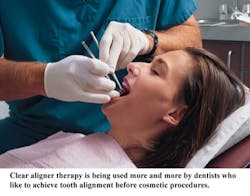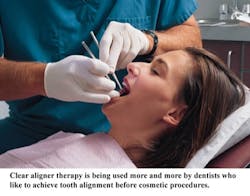A Clear Choice in the Dental Aligner Market
by Del Williams
Doctors welcome options that provide consistency, flexibility, and affordability General practitioners and orthodontists are re-evaluating whether or not their clear dental aligner partners truly have their best interests at heart. "For the good of the patient and doctor, we've needed more choice in the clear aligner market," says Thomas Swonke, DDS, a dentist and orthodontist with two practices in the Houston, Tex., area. "Like democracy, with greater choice comes greater competition and benefit."Companies like ClearCorrect — the Houston-based company founded by Dr. Willis Pumphrey in 2006 — provides options that doctors want, including one-time training as opposed to the required annual certification that takes substantial hours away from other CE requirements. The company's program also helps to lower doctors' costs as much as 40% while eliminating the add-on fees that can erode profit margin and peace of mind."When I first started using aligners, I had little choice in product," says Dr. Swonke. "Not only were the aligners priced beyond the ability of some of us to pay, but there were also add-on fees for mid-course corrections, final retainers, and such. I always thought in the back of my mind, 'If I do this, what will it cost?' I wanted my focus to be on providing the best patient care and treatment, not on cost accounting."While the market for clear dental aligners is growing rapidly — especially for general dentists previously unable to offer orthodontic-related procedures — the barriers of cost and annual training hours, as well as previous minimum caseload requirements, have limited the marketplace opportunities of many.
When Dr. Swonke turned to clear aligners from ClearCorrect, he was pleased that the aligners could be used as needed for patients without annual criteria or quota. "I like the flexibility of using the aligners when it makes sense for the patient without outside pressure," he says.
He also appreciates that once a doctor takes the company's one-time training via workshop, Internet webinar, or upcoming self-paced online training, there's no more required class work, though advanced training is available and encouraged.
Perhaps the most important way that doctors can maximize their patient and practice benefits, however, is to lower the cost of aligners to make them more affordable and profitable.
Swonke's thoughts mirror those of Willis Pumphrey, DDS, a pioneer in clear aligner therapy. The veteran dentist, like his colleagues, found the larger aligner companies prohibitive to the needs of his practice. Dr. Pumphrey had switched to a less expensive alternative. But when that company was bought, leaving 400 of his patients stranded mid-treatment, he decided to create his own aligners.
Pumphrey's company ClearCorrect, a brand created by doctors for doctors, does not charge for mid-course corrections, refinements, or final retainers. The company ships its aligners four trays at a time. This helps keep down lab-fees, since it eliminates the waste of shipping unnecessary aligners if mid-course corrections are required. Doctors typically get four sets of trays every 12 weeks if no course changes are needed. The result — a 32-step clear aligner program for $995 and a 12-step program for $595 — gives doctors the ability to focus on treatment outcomes without worrying about price. This makes treatment more affordable and profitable.
For more information about ClearCorrect, call (888) 331-3323 toll-free, visit www.clearcorrect.com, or write to ClearCorrect, Inc. at 5200 Mitchelldale St., Suite F-26., Houston TX 77092.



